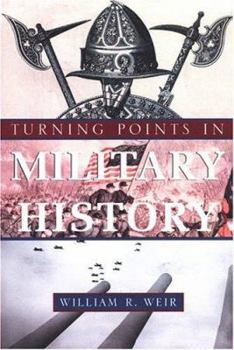Turning Points in Military History
Select Format
Select Condition 
Book Overview
Military historian William R. Weir looks at the key developments in armoury, men, and strategies that forever changed the evolution of war. Weir analyses the evolving interrelationships between these developments to give readers a thorough picture of this fascinating and important subject. Here are fifty turning points that radically changed the face of warfare and, ultimately, the course of history. From the development of basic weapons using wood...
Format:Paperback
Language:English
ISBN:0806526270
ISBN13:9780806526270
Release Date:January 2005
Publisher:Citadel Press
Length:298 Pages
Weight:0.80 lbs.
Dimensions:0.9" x 6.0" x 9.0"
Customer Reviews
3 ratings
A solid review of military history
Published by Thriftbooks.com User , 17 years ago
I give this book 4 stars. It covers a lot of ground and connects a lot of topics, but there is room for improvement. For starters, there could be more (or any) illustrations to help the reader understand what he is trying to describe--for example, the petard (pg 57). Also, he often discuss battles that, while incorporating relatively new technologies, do not introduce anything new. These discussions are enough to whet the appetite for more study, but don't seem to contribute to the book's theme. For example, Gustavus v Wallenstein, pg 101. Having read this book immediately after Carnage and Culture, I was interested in Weir's disparaging comments regarding C & C's theme (that the western way of war dominates) on pg 28, stemming from the battle of Parthians v Romans (Crassus). However, the rest of the book could be a rehash of the arguments from C & C, as there is not a single turning point cited that is of non-western origin. Finally, the book ends with a non-sequitur of a discussion of the state of Iraq in 2004. While it would be good opinion page material, it seems to have nothing to do with a turning point in military history. Overall, a solid book that covers the history of how the modern military got from clubs to precision guided munitions.
Informative but somewhat superficial
Published by Thriftbooks.com User , 17 years ago
This book is very informative, but somewhat superficial. It covers the evolution of military equipment and tactics from the Stone Age to 2004, and does this all in only 263 pages. To do this the book must of necessity be somewhat superficial and to some degree this superficiality is both its strength and weakness. It is strength because the reader is not subjected to a dense tome on military history and strategy and a weakness if one is interested in a more in-depth treatment. For the general reader, I think that the strength outweighs the weakness. Air power and sea power are discussed in addition to land warfare. The book is organized along a time line starting in the Stone Age, with edged stone weapons and simple spears and bows. It then goes on to warfare conducted by urban centers, starting with the Greek city-states. A constant theme is how the organization of armies evolved, starting with poorly controlled masses and on to the organized Greek phalanx and Roman legion and how this resulted from the development of new weapons and tactics. This book covers a lot of history in addition to a discussion of military tactics. It emphasizes how historical trends led to new ways of fighting. For instance, how the European wars of the Reformation led to the development of standing armies and how the costs involved led to limited wars. This changed with the French revolution, with the formation of a national French army. The style of writing is clear and this should be a quick and entertaining read for those interested in military history, although experts may find the material a bit superficial.
Great narrative overview of military change
Published by Thriftbooks.com User , 19 years ago
Weir's book is an easy to read historical narrative covering the history of military change from pre-history to the present. If you're looking for a general overview, without getting into the theoretical aspects of military revolution or revolutions in military affairs, this is the book for you. At the same time it would certainly be a first choice if you want a top line perspective before descending into the depths of more academic and detailed works such as William H. McNeill's THE PURSUIT OF POWER, which Weir frequently cites throughout his own book. The book's strength is its ability to easily explain the generally accepted turning points around which military strategy and tactics evolved. Another good point about the book is that, although it recognizes the influence of technology, it also recognizes that it's more than technology and addresses those points throughout the book. He even admits that, "Not all turning points are created by new weapons. Sometimes it's a matter of attitude." He also includes separate chapters on the impact of gunpowder, the evolution of warfare at sea, the development of standing armies, limited warfare, and nations in arms. What Weir really provides is a good synthesis of notable turning points that, sometimes over time, seriously change the way war was fought.






